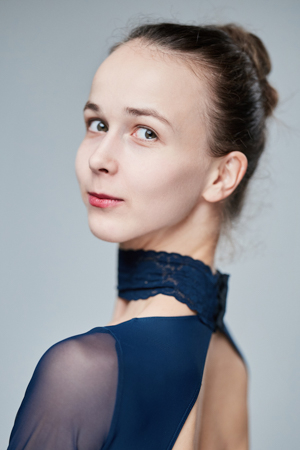
3 January 2026 |
Ilyushkina’s Odette is surprisingly un-contemporary in the finest sense of the phrase – it cannot be said that the image has been created “vintage-style”, yet at the same time the careful port de bras, the movement of the arms, the poses revealed and the foreshortening of the duet supports appears like a delicate reminiscence, a hint at images of the past on which the ballerina as if casts her gaze. Apropos, even without this elegant stylisation Maria herself seems to belong rather to “that” era than “this”. The “white” acts are chaste and sublime. Here the unmistakable spiritual lyricism is important, the playfulness of the swanlike lines of the body, the focus on classical purity of dance. The beautiful refrain of the White Adagio resounded with a soaring arabesque in which the dancer froze for several seconds.
Yekaterina Pollak. Beatrice Magazine. 15.01.2020
Her dance is something sacral. And so it is beyond any categories of purity and academism, it is beyond the criteria of technique. The more so, as Maria technically copes with everything: she neither simplifies nor lets slip a single movement. In the “Dance with the Serpent” [in La Bayadère] even professionals are amazed at her technical refinement: her free développé en arabesque and her sous-sus with her distinct leg en pointe. In the third act, she crowns the mysterious action of the coda with her pas glissé to the top of the very stage – a feat capable far from everyone – and she also adorns it with counterpoint from her flowing port de bras. In the act of the “Shades” the inner whiteness and purity of performance take on an external form. Just like love, from the very first bearing features of the ethereal, it takes on a higher form.
Arseny Surzha. Blog of Teatr magazine. 31.12.2021
… In the pointe prologue [of The Sleeping Beauty] Maria Ilyushkina softened the impeccability of her dance with a tender sophistication; in the other acts, exhibiting high heels and late 19th century fashions, miming sincerely and expressively.
Tatiana Kuznetsova. Kommersant. 18.02.2022
• Recipient of Ballet magazine’s Spirit of Dance prize in the category “The Ballet Star” (2025)
• Winner (together with Even Capitaine) of Rossiya-Kultura TV's project Grand Ballet (2024)
• Prize-winner at the XIV International Ballet Dancers’ and Choreographers’ Competition in Moscow (1st prize, 2022)
• Prize-winner at Valentina Kozlova International Ballet Competition (New York, 2016, gold medal)
Born in St Petersburg.
Graduated from the Vaganova Academy of Russian Ballet in 2016 (class of Yulia Kasenkova). Joined the Mariinsky Ballet in 2016. Soloist from 2020. Principal since 2025.
Repertoire includes:
La Sylphide (Sylphs); choreography by August Bournonville, revised version by Elsa-Marianne von Rosen,
Giselle (Giselle, Monna); choreography by Jean Coralli, Jules Perrot and Marius Petipa,
La Fille du Pharaon (Aspicсia); choreography by Marius Petipa reconstructed by Toni Candeloro,
La Bayadère (Nikia, Trio of Shades, D’Jampe, Grand pas); choreography by Marius Petipa, revised version by Vakhtang Chabukiani and Vladimir Ponomarev,
The Sleeping Beauty (Lilac Fairy, Maids of honor of Aurora); choreography by Marius Petipa, revival of the 1890 production, staging by Sergey Vikharev,
The Sleeping Beauty (Aurora, Lilac Fairy, Princess Florine, the Tenderness Fairy); choreography by Marius Petipa, revised version by Konstantin Sergeyev,
“Paquita” Grand Pas (variation); choreography by Marius Petipa,
Pas de deux from the ballet The Talisman; choreography by Marius Petipa,
Swan Lake (Odette-Odile, Brides of the Prince, Swans); choreography by Marius Petipa and Lev Ivanov, revised version by Konstantin Sergeyev,
Raymonda (Raymonda, variation in the scene Dream); choreography by Marius Petipa, revised version by Konstantin Sergeyev,
Le Réveil de Flore (Diane); reconstruction of the 1894 production by Marius Petipa and Lev Ivanov, revival by Sergei Vikharev,
Le Corsaire (Medora); production by Pyotr Gusev after the composition and choreography by Marius Petipa,
Don Quixote (Queen of the Dryads); choreography by Alexander Gorsky after motifs of the production by Marius Petipa,
Le Carnaval (Estrella, Chiarina), Chopiniana (Nocturne, Seventh Waltz, Mazurka, Prelude), The Swan; choreography by Michel Fokine,
Jewels (Emeralds, Diamonds), Serenade, Symphony in C (II. Adagio – soloist, IV. Allegro vivace); choreography by George Balanchine,
The Nutcracker (Masha, Waltz of the Flowers); choreography by Vasily Vainonen,
The Fountain of Bakhchisarai (Maria, Young Polish Noblewomen); choreography by Rostislav Zakharov,
Romeo and Juliet (Juliet); choreography by Leonid Lavrovsky,
Sylvia (Ceres); choreography by Frederick Ashton,
Grand pas classique; choreography by Victor Gzovsky,
The Legend of Love (Mekhmeneh Bahnu), The Stone Flower (Amethysts); choreography by Yuri Grigorovich,
Cinderella (Khudyshka),
The Nutcracker (the Nutcracker’s Sisters); production by Mihail Chemiakin, choreography by Kirill Simonov,
The Bronze Horseman (The “Queen” of the Ball, Contredanse); choreography by Rostislav Zakharov, Yuri Smekalov,
Paquita (Paquita, Paquita’s Friends); choreography by Yuri Smekalov, reconstruction and staging of Marius Petipa's choreography (Act III Grand Pas) by Yuri Burlaka,
as well as dances in the opera A life for the Tsar (the Queen of the Ball).
Repertoire also includes:
The Sleeping Beauty (Princess Aurora); choreography by Marius Petipa, revised version by Konstantin Sergeyev and Eldar Aliev, performance by the Primorsky Stage of the Mariinsky Theatre,
Elegy; choreography by Alexander Polubentsev.